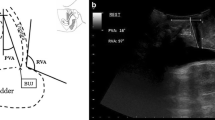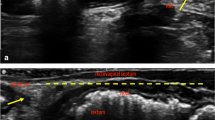Abstract
The aim of the study was to compare visual assessment of anterior vaginal wall descent with the Q-tip test in evaluating urethrovesical junction mobility. One hundred and eleven patients with prolapse and/or urinary incontinence were examined in the supine lithotomy position with an empty bladder. Maximum straining Q-tip tests and maximum descent of the anterior vaginal wall were measured. Using each centimeter of descent as a cutoff value, the sensitivities, specificities and positive and negative predictive values were compared to those of the Q-tip test. As the cutt-off points were moved distally, specificity increased at the expense of sensitivity. There was no single cut-off point that provided adequate sensitivity and specificity to be clinically useful to replace the Q-tip test. It was concluded that visual assessment of anterior vaginal wall descent does not provide diagnostic accuracy and acceptable sensitivity and specificity to determine urethrovesical junction mobility. Other methods should be employed to assess support.
Similar content being viewed by others
References
Bergman AA, Koonings PP, Ballard CA, Negative Q-tip test as a risk factor for failed incontinence surgery in women.J Reprod Med 1989;34:193–197
McGuire EJ, Lytton B, Pepe V, Kohorn EI. Stress urinary incontinence.Obstet Gynecol 1976;47:255–264
Crystle CD, Charme LS, Copeland WE. Q-tip test in stress urinary incontinence.Obstet Gynecol 1971;38:313–315
Bergman A, Vermesh M, Ballard CA, Platt LD. Role of ultrasound in urinary incontinence evaluation.Urology 1989;33:443–444
Bhatia NN, Ostergard DR, McQuown D. Ultrasonography in urinary incontinence.Urology 1987;29:90–93
Kitzmiller JL, Manzer GA, Nebel WA, Lucas WE. Chain cystourethrogram and stress incontinence.Obstet Gynecol 1972;39:333–340
Bump RC, Mattison A, Bo K et al. The Standardization of terminology of female pelvic organ prolapse and pelvic floor dysfunction.Am J Obstet Gynecol 1996;175:10–17
Bergman A, McCarthy TA, Ballard CA, Yanai J. Role of the Q-tip test in evaluating stress urinary incontinence.J Reprod Med 1987;32:273–275
Montz FJ, Stanton SL. Q-tip test in female urinary incontinence.Obstet Gynecol 1986;67:258–260
Farrell SA, Ostergard DR. Choice of surgical procedure for stress incontinence. In: Benson JT, ed. Female pelvic floor disorders; investigation and management. New York: WW Norton, 1992:232–236
Caputo RM, Benson JT. The Q-tip test and urethrovesical junction mobility.Obstet Gynecol 1993;82:892–896
Kolbl H, Bernaschek G, Wolf F. A comparative study of perineal ultrasound scanning and urethrocystography in patients with genuine stress incontinence.Arch Gynecol Obstet 1988;244:39–45
Schaer GN, Koechli OR, Schuessler B, Haller U. Perineal ultrasound for evaluating the bladder neck in urinary stress incontinence.Obstet Gynecol 1995;85:220–224
Gordon D, Pearce M, Norton P, Stanton SL. Comparison of ultrasound and lateral chain urethrocystography in the determination of bladder neck descent.Am J Obstet Gynecol 1989;160:182–185
Handa VL, Jensen JK, Ostergard DR. The effect of patient position on proximal urethral mobility.Obstet Gynecol 1995;86:273–276
Author information
Authors and Affiliations
Additional information
Editorial Comment: Many clinicians claim that they can assess urethrovesical junction mobility visually and thus avoid employing other means, such as the Q-tip test, ultrasonography, bead-chain cystography or fluoroscopy. Montella et al. evaluate a technique of visual assessment of urethrovesical junction mobility based on the International Continence Society's Standardization of Terminology of Female Organ Prolapse and Pelvic Floor Dysfunction as compared to evaluation with the Q-tip test. Their results clearly indicate that this technique (measurement of the descent of point Aa) does not provide adequate sensitivity or specificity in determining urethrovesical junction descent compared to the Q-tip test. Although this technique was only compared to the Q-tip test and not all other modalities available, it is doubtful that visual assessment of anterior wall descent at any level would correspond to urethrovesical junction mobility, as is discussed very succinctly by the authors.
Rights and permissions
About this article
Cite this article
Montella, J.M., Ewing, S. & Cater, J. Visual assessment of urethrovesical junction mobility. Int Urogynecol J 8, 13–17 (1997). https://doi.org/10.1007/BF01920288
Issue Date:
DOI: https://doi.org/10.1007/BF01920288




